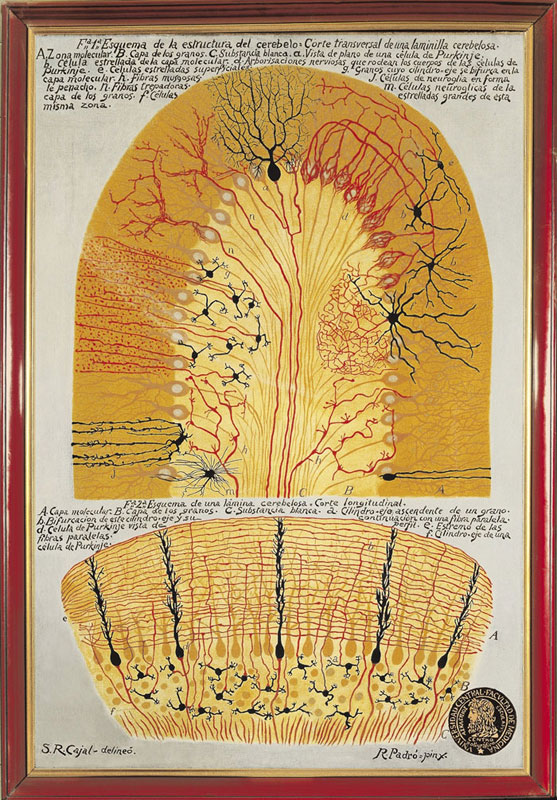
Here are two cutaway views of the cerebellum, which coordinates movement. The top drawing has a rich diversity of cells, including treelike Purkinje cells, seen in red and tan, and stellate cells, shown in black. The bottom drawing is a longitudinal cross section of the cerebellum.
Anatomist Santiago Ramon y Cajal was the first to see–and illustrate–what neurons really do. His exquisitely detailed drawings changed our understanding of the brain and nervous system. Cajal relentlessly pursued his microcopic study of animal tissues, leading to an essential discovery: Brain signals jump from cell to cell rather than flow through a continuous web of fibers, as was believed at the time.See more of these exquisite illustrations in Discover
The Scientist Who Drew Brains, and Then a Nobel Prize.
Source: Discover

istockphoto
en who have difficulty falling asleep are at greater risk of depression than those who nod off easily, researchers have found.
A study at the Western Australian Centre for Health and Ageing at The University of Western Australia found that difficulty falling asleep doubles the risk of depression in older men.
Sleep complaints are common in later life with nearly 50 per cent of people older than 65 years reporting trouble falling or remaining asleep.
“We found a strong link between difficulty falling asleep and depression which cannot be explained adequately by reverse causality that is, that depression causes insomnia. We didn’t expect to find this result, so it took us by surprise,” said UWA Chair of Geriatric Psychiatry and Director of Research at the Western Australian Centre for Health and Ageing, Winthrop Professor Osvaldo Almeida.
“Excuse the pun, but our results are a wakeup call. I believe that clarifying what drives the association between sleep problems and depression should become an international research priority. Worryingly, our results are consistent with the possibility that the use of sleeping tablets is actually driving this increase in the risk of depression. Addressing this issue may guide the development of prevention strategies to decrease the burden of depression in our society. [continue reading…]

istockphoto
Marijuana is the most prevalent illicit drug used by teenagers and adults around the world. Nearly a third of high school students in the United States report smoking it, and most high schoolers say they have access to the drug.
To many people, smoking pot is no big deal. They cite reasons such as: “it isn’t dangerous or addictive” and “everybody is doing it.”
Denise Walker, co-director of the University of Washington’s Innovative Programs Research Group, disagrees.
“It’s not a risk-free drug,” she said. “Lots of people who use it do so without problems. But there are others who use it regularly – almost daily – and want to stop but aren’t sure how.” [continue reading…]
 Can graphic images persuade people to make lasting changes to their behavior? The answer, according to psychological research, is probably not.
Can graphic images persuade people to make lasting changes to their behavior? The answer, according to psychological research, is probably not.
Dr. Howard Leventhal, the Board of Governors Professor of Health Psychology at Rutgers, agrees that photos are in fact stronger than words, but that images may not lead to long-term behavioral effects. Leventhal states, “You don’t need a lot of threat to get something to happen as long as the threat is associated with a clear, simple plan of action. For cigarettes, it’s more complicated, you may need a more potent level to get people to change.”
Leventhal continues, “The problem that I had with [the new Food and Drug Administration cigarette warning labels is that] it isn’t as clear to me as it might be whether there was a specific plan for action that was linked to the images. In other words, you get people motivated but if you don’t provide some concrete and specific directions for behavior, they might habituate to the threat and go ahead and do it anyway.”
These extremely graphic images, which include rotting teeth, blackened lungs, and a dead body, are intended to deter people from smoking. Paul Slovic, professor of psychology at the University of Oregon, says these warning labels may “change the aura and image about smoking for young people who haven’t yet started to smoke or are in the early stages.” But these images are unlikely to change the behavior of current smokers.
In addition, according to Carol Tavris, social psychologist and author of a recent book on cognitive dissonance, “What we know from decades of social psychological research is that fear backfires.”
Source: Association for Psychological Science




